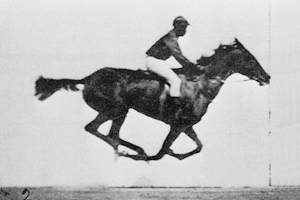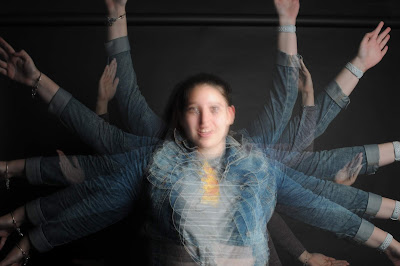Definition: is a photography technique of combining two or numerous separate exposures into one
How to achieve this:
1. Tripod
2. Slow shutter speed, 3 - 4 seconds
3. Manual camera settings
4. Manual focus
5. Black background
6. No camera shake ( careful when pressing the button and to not move the camera after it has been set)
7. Direct the shoot ( framing and knowing where the moving elements will form )
8. Soft box lighting
9. Photo-editing software ( Photoshop )
Image Bank
Research
Eadwearde MuyBridge - The Horse in Motion, 1878
He was an English-American photographer that pioneered the early work in motion and motion-picture projection. He was born in 1930 in Kingston upon Thames, England and dead in 1904 in the same place.
The experiments in photographing motion started when he was asked by Leland Stanford to prove if a horse in trotting had all four legs of the ground simultaneously.
He used multiple cameras to capture motion, this is stop motion.
Stop motion is an animated film making technique in which objects are physically manipulated in small stages being individually photographed frames. This will appear to exhibit independent motion when the frames are played back as a fast sequence. Stop motion using humans is sometimes referred to as pixilation.
An early device for displaying moving images is called a zoographiscope and is how the movie projector originated from.The projector used 16" glass disks onto which Muybridge had an unidentified artist paint the sequences as silhouettes. This technique eliminated the backgrounds and enabled the creation of fanciful combinations and additional imaginary elements. Only one disk used photographic images, of a horse skeleton posed in different positions. The machine was hand-cranked.
An animated GIF of a photographic sequence shot by Eadweard Muybridge in 1887. His chronophotographic works can be regarded as movies recorded before there was a proper way to replay the material in motion.
Original Photos
Settings
1. Manual setting
2. Shutter speed - 4 seconds
3. Aperture - F 22
4. ISO - 200
Studio Equipment
1. Soft box light
2. Remote trigger ( flash )
3. Black background
4. No external light
Analyse of photos
For all the photos the technique worked really well and i got the effect i was looking for. If i wanted more movement i could increase the shutter speed and at the same rate increased the amount of times i used the flash. I had to adjust the position of the camera by moving the tripod as in the first photo i captured the edge of the black background i was using.
My favourite is the last photo as i really had an idea of what i wanted to capture. I really like how the the camera captured the all the movement in the photo and blurred all the features on the face and body.
Am I going to use this technique in my project ?
I am most likely not going to use this technique in my work as i do not have access to the correct equipment. As well as this i am doing my project outside and i am looking at buildings and streets. This technique would blur the photos i would be trying to take as a result of the long exposure.









No comments:
Post a Comment